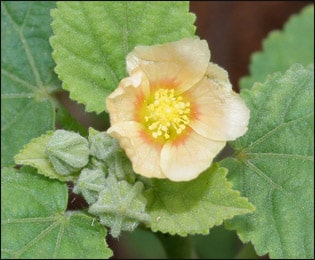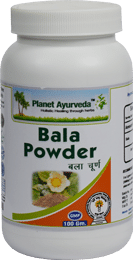Bala (Sida Cordifolia) - Properties, Benefits & Dosage

Description of Bala plant
Bala botanical name is Sida cordifolia. Sida cordifolia is perennial herb that grows 30mts in height. Bala Leaves are oblong or ovate and are 2.5-7cm long and 2.5-5cm broad with 6-7 veins. Bala leaves are serrate, truncate and heart-shaped. Plant bears small, solitary, axillary and white or yellow colored flowers. Both Bala roots and stems are stout and strong. Bala Roots are bitter in taste, odorless and grayish yellow in color. Tap roots are generally branched at the tip. Bala Fruits are moong sized, disc-shaped and velvety in upper half about 6-8mm in diameter. Bala Seeds are smooth and grayish black in color and are called bajibanda in Ayurveda. Flowering season of plant is August to December and fruits appear from October to January.
General Description
Bala and country mallow are common names of Sida cordifolia. Bala Plant is used to prepare medicine in ayurvedic medicine system. According to Ayurveda it is used to pacify all three body energies i.e. vata, pitta and kapha but is most effective for vata dosha. Bala is much known for its shukrala properties and it is used to increase the shukra dhatu. It is used to improve both quality and quantity of sperm count. In Ayurveda this herb is used as CNS depressant, analgesic, anti-inflammatory, hypotensive and hypoglycemic agent. It is best rasayan and nervine tonic for various vata disorders. Bala is best blood purifier and best used for piles and raktapitta. It also boosts fetal growth. Cooked leaves are used to cure bleeding piles.
Major chemical compounds available in this plant are ephedrine, sterculic acid, malvalic and coronaric acid, pseudoephedrine, fatty acid, saponine, hypaphorine, ecdysterone, indole alkaloids, palmitic acid, stearic acid and ole-beta-sitosterol. Sida contains both ephedrine and pseudoephedrine both the chemical compounds are used to stimulate central nervous system.
Bala Classification
- Kingdom - Plantae
- Order - Malvales
- Family - Malvaceae
Bala Habitat
Sida cordifolia is commonly known as bala, it is a common weed that grows along wastelands and roadsides and is native to India. Bala is found throughout tropical and sub-tropical regions of India and Sri Lanka. It is considered as invasive weed in Africa, Australia, Hawaiian island, Southern United States and New Guinea.
Bala Names
- Latin name - Sida cordifolia
- Common name - Country mallow, Heart-leaf sida
- Sanskrit name - Badiyalaka, Bala, Baladaya
- Bengali name - Berela
- Assamese name - Bor sonborial
- Hindi name - Kharinta, Barial
- Kannada name - Chittuharalu, Hettuti-gida
- Malayalam name - Katturam
- Tamil name - Chittamuttie
- Telugu name - Chirubenda, Mailmanikkam
- Marathi name - Bala, Chikana, Tupkaria
- Oriya name - Bajromuli, Bisiripi
- Marathi name - Chikana, Karaiti
- Gujarati name - Jangli methi
- Chinese name - Yuan ye jin wu shi hua, Ke dong, Xin ye huang hua ren
- French name - Herbe de douze heyres
- Japanese name - Maruba kingojika
- Nepalese name - Balu
- Russian name - Sida Kordifolia, Sida Serdtselistania
- Spanish name - Escoba Negra, Escobilla, Llima
- Thai name - Ya khat bai pom
Ayurvedic Properties of Bala
| Hindi / Sanskrit | English | ||
| Rasa | Madhura | Taste | Sweet |
| Guna | Laghu, Snigdha, Pichila | Physical Property | Light, Unctuousness, Sticky |
| Virya | Sheeta | Potency | Cold |
| Vipaka | Madhura | Metabolic Property (After Digestion) | Sweet |
Bala Effects on Doshas
It balances all three doshas (Vata, Pitta & Kapha).
| Charak Samhita | Sushrut Samhita |
|
|
Ancient Verse about Bala(Sida Cordifolia)


The Bhavprakash nighantu Twenty Eighth edition of 2010: verse 142-144, page no-381.
- It states that sida has four different types; bala, vatvallika, vatya and vatylaka are various names of bala. Mahabala, peetpushpa and sehdevi are synonyms of mahabala. Atibala, rishyaprokta, kantika are synonyms of atibala. Gangeruki, nagbala, jhasha and hrasavedhuka are synonyms of nagabala.
- Second verse states that all four types of bala are cold in potency, sweet in taste and are aphrodisiac, improves skin texture and glow, unctuous and absorbent. It is used to pacify vata dosha, bleeding disorders and to cure wounds.
References
The Bhavprakash nighantu with elaborated Hindi commentary by Padmashri prof. K.C.Chunekar, edited by Late Dr. G.S.Pandey: Twenty Eighth edition of 2010: gudchayadi varga; verse 142-143, page no-381.
Practical Uses of Bala (Sida Cordifolia)
- Bala is anti-inflammatory in nature and it is used to reduce the inflammation of wounds and eyes. Its external application is used to reduce arthritis pain and other joint stiffness. Its external paste is used in ophthalmic disease and wound healing.
- Oil prepared from this herb is very effective for the sufferers of cervical spondylitis, paralysis and facial paralysis.
- Helps in the absorption of both water and nutrients from the intestine and very effective to control the motility of intestine. Due to these properties this herb is very effective in irritable bowel syndrome or grahani.
- It is also used to reduce petechial hemorrhage and is used as cardiac tonic.
- Bala is used to treat both male and female infertility. In males it increases sperm count and used to increase motility of sperms. In Ayurveda this herb is called vrishya i.e. Aphrodisiac. It is used to treat male erectile dysfunction and premature ejaculation.
- It helps to rejuvenate urinary system and this herb act as diuretic and helps to treat cystitis.
- Bala herb is used to reduce chest congestion and it is very useful for bronchitis, asthma and stomatitis.
- Root infusion of Sida cordifolia is very effective for nervous and urinary system disorders. It is also used for treating blood and bile disorders.
- It is used to pacify all three dosha vata, pitta and kapha.
Part used
- Bala Roots
- Bala Bark
- Bala Leaves
- Bala Flowers
- Bala Seeds
Dosage
- Powder - 3-6gms
- Juice extract - 10-20ml
- Decoction - 50-100ml
Cautions
Sida cordifolia contains ephedrine and excessive use of these herb causes:-
- Insomnia
- Anxiety
- Nervousness
- Rise in blood pressure
- Memory loss
- Stroke
Planet Ayurveda Products that Use Bala
Bala Powder
Bala Powder is best formulation of Planet Ayurveda. This dietary supplement is made by pure extract of sida cordifolia. It is best supplement to boost and maintain body's overall health and immunity. This powder keeps healthy energy level of body. It is also used to maintain health of muscles.




